
I don’t believe an entire decade can be summed up with ten films. But with twenty films it covers the broader range! And after twenty, I wanted to mention twenty-five! These core films of the 1990’s do say something about the culture, the information breakthroughs, and represent the artistic pinnacles.
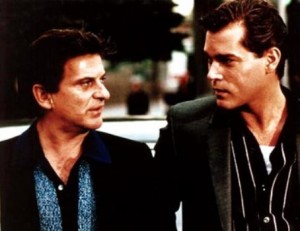 1. GoodFellas (1990) – Robert DeNiro, Ray Liotta and Joe Pesci in the untouchable Martin Scorsese film that immortalized them. We are taught by grade one that murder, robbery, loan sharking and all that other mayhem stuff is a sin. We know that these wiseguys are a morally corrupt outfit and yet it so appealing and tantalizing that you can’t help but fantasize being a part of it. “The Godfather” is a classic handsome Greek tragedy of a film, but have you ever fantasized about being one of the Corleones? The cars, the booze, the nightclubs, the all-night card playing, the stacks of money, the mistresses, the fur coats, the ball-busting… what a glorious time. The problem is the 1950’s and ’60’s didn’t last forever, for the coolness of gangster life was trashed by 80’s drug-dealing. If you have never seen a Scorsese film, which should be a constitutional duty in this lifetime, then start here. Arrive at the scene where the camera tours through a red-lamp nightclub via the backdoors, then through the kitchen, and then onto its service floor so Liotta and Lorraine Bracco get seated at their exclusive table, and you will begin to understand why Scorsese is such a huge deal.
1. GoodFellas (1990) – Robert DeNiro, Ray Liotta and Joe Pesci in the untouchable Martin Scorsese film that immortalized them. We are taught by grade one that murder, robbery, loan sharking and all that other mayhem stuff is a sin. We know that these wiseguys are a morally corrupt outfit and yet it so appealing and tantalizing that you can’t help but fantasize being a part of it. “The Godfather” is a classic handsome Greek tragedy of a film, but have you ever fantasized about being one of the Corleones? The cars, the booze, the nightclubs, the all-night card playing, the stacks of money, the mistresses, the fur coats, the ball-busting… what a glorious time. The problem is the 1950’s and ’60’s didn’t last forever, for the coolness of gangster life was trashed by 80’s drug-dealing. If you have never seen a Scorsese film, which should be a constitutional duty in this lifetime, then start here. Arrive at the scene where the camera tours through a red-lamp nightclub via the backdoors, then through the kitchen, and then onto its service floor so Liotta and Lorraine Bracco get seated at their exclusive table, and you will begin to understand why Scorsese is such a huge deal.
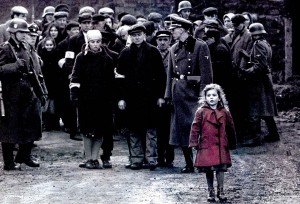 2. Schindler’s List (1993) – When it’s over, it is emotionally overwhelming in the most positive respect. Perhaps you have never considered yourself one that could handle a Holocaust film but deep down you want to see just one so you get the Holocaust in one swing. “List” did more than transform public perception of the horrors of the Holocaust – it was the first big budget film to depict bloody horrors, the mass genocide, and the few lucky to get out – it had transformed director Steven Spielberg as well who found his spiritual calling when he created the Shoah Visual History Foundation after the film was released. Liam Neeson is the enterprising businessman who came to Nazi-occupied Poland to exploit Jews as free labor but then became a humanitarian when he witnessed genocide in Krakow. Ralph Fiennes is the Nazi prison camp commandant Amon Goeth, unblinking in his evil and alliance to National Socialism. Ben Kingsley is Itzhak Stern, the Jewish accountant and Schindler’s right-hand man. Somehow we feel like we meet the 1,100 people too that were saved. Artistically, the black & white is not only essential, it is a definitive example what the best high contrast lighting cinematography can do.
2. Schindler’s List (1993) – When it’s over, it is emotionally overwhelming in the most positive respect. Perhaps you have never considered yourself one that could handle a Holocaust film but deep down you want to see just one so you get the Holocaust in one swing. “List” did more than transform public perception of the horrors of the Holocaust – it was the first big budget film to depict bloody horrors, the mass genocide, and the few lucky to get out – it had transformed director Steven Spielberg as well who found his spiritual calling when he created the Shoah Visual History Foundation after the film was released. Liam Neeson is the enterprising businessman who came to Nazi-occupied Poland to exploit Jews as free labor but then became a humanitarian when he witnessed genocide in Krakow. Ralph Fiennes is the Nazi prison camp commandant Amon Goeth, unblinking in his evil and alliance to National Socialism. Ben Kingsley is Itzhak Stern, the Jewish accountant and Schindler’s right-hand man. Somehow we feel like we meet the 1,100 people too that were saved. Artistically, the black & white is not only essential, it is a definitive example what the best high contrast lighting cinematography can do.
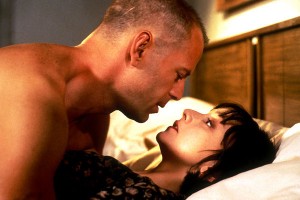 3. Pulp Fiction (1994) – Bloody crime story gone black comedy. John Travolta and Samuel L. Jackson’s first wacky dialogue together – you must applaud aloud. Travolta and Uma Thurman’s dance scene, stand up and cheer. The adrenaline needle, shriek loud. You’re one of the luckiest people ever if you saw this in full packed house the weekend it opened. If you haven’t seen it yet, it won’t compare, but at least get a pack of people over to watch it with you as a midnight party movie. Christopher Walken has a bravura gonzo monologue. Bruce Willis is a boxer who refuses to fold so he goes on the run. Amanda Plummer and Eric Roth are stick-up robbers at a restaurant. Ving Rhames is the smoothest velvet-tongued mob boss you’ve ever heard, he later gets a gag ball in his mouth. Oh, the dungeon and samurai sword scene, what a freak out. All part of nonlinear, multi-part plot with interlocking stories that double over themselves sometimes. Quentin Tarantino’s definitive film is also full of mean-streets-goes-loony-toons dialogue that made it as famous as any screenplay ever written, but it is Harvey Keitel as Mr. Wolf who gets the wickedest line. None of these actors would ever seem as iconic outside of this film ever again (except Jackson, who continues to push the envelope). In Tarantino-land, even the silences are riveting.
3. Pulp Fiction (1994) – Bloody crime story gone black comedy. John Travolta and Samuel L. Jackson’s first wacky dialogue together – you must applaud aloud. Travolta and Uma Thurman’s dance scene, stand up and cheer. The adrenaline needle, shriek loud. You’re one of the luckiest people ever if you saw this in full packed house the weekend it opened. If you haven’t seen it yet, it won’t compare, but at least get a pack of people over to watch it with you as a midnight party movie. Christopher Walken has a bravura gonzo monologue. Bruce Willis is a boxer who refuses to fold so he goes on the run. Amanda Plummer and Eric Roth are stick-up robbers at a restaurant. Ving Rhames is the smoothest velvet-tongued mob boss you’ve ever heard, he later gets a gag ball in his mouth. Oh, the dungeon and samurai sword scene, what a freak out. All part of nonlinear, multi-part plot with interlocking stories that double over themselves sometimes. Quentin Tarantino’s definitive film is also full of mean-streets-goes-loony-toons dialogue that made it as famous as any screenplay ever written, but it is Harvey Keitel as Mr. Wolf who gets the wickedest line. None of these actors would ever seem as iconic outside of this film ever again (except Jackson, who continues to push the envelope). In Tarantino-land, even the silences are riveting.
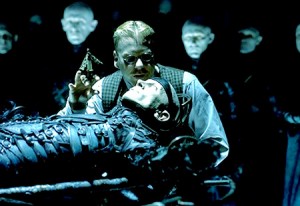 4. Dark City (1998) – The poster looked like “Hellraiser” goes to Mars, not looking like one of the best movies ever made which is what it is. Without a standard advertising gimmick (we’re better off without ads telling us everything anyway), this got brushed under the rug and other subsequent sci-fi’s like “The Matrix” became more famous. But this really is the most staggering, most visually awesome and story-rich sci-fi film of the last forty years. Imagine that – nobody has done better in this many years! Not since “2001,” I would say. Rufus Sewell, Kiefer Sutherland, Jennifer Connelly and William Hurt are the stars (okay not as famous as Keanu, get over it). Rufus is an amnesiac trying to figure out who he is after he blacked out. The setting is an abstract architectural dreamscape – an amalgam of the ’30’s, ’40’s, comic books of the antique yesteryears. The feeling is a noir universe of awesome converting objects and shape-shifting images. Theme: The question of whether human memory is part of the human soul? Whoa, Keanu would say. Weird and hella’ fun.
4. Dark City (1998) – The poster looked like “Hellraiser” goes to Mars, not looking like one of the best movies ever made which is what it is. Without a standard advertising gimmick (we’re better off without ads telling us everything anyway), this got brushed under the rug and other subsequent sci-fi’s like “The Matrix” became more famous. But this really is the most staggering, most visually awesome and story-rich sci-fi film of the last forty years. Imagine that – nobody has done better in this many years! Not since “2001,” I would say. Rufus Sewell, Kiefer Sutherland, Jennifer Connelly and William Hurt are the stars (okay not as famous as Keanu, get over it). Rufus is an amnesiac trying to figure out who he is after he blacked out. The setting is an abstract architectural dreamscape – an amalgam of the ’30’s, ’40’s, comic books of the antique yesteryears. The feeling is a noir universe of awesome converting objects and shape-shifting images. Theme: The question of whether human memory is part of the human soul? Whoa, Keanu would say. Weird and hella’ fun.
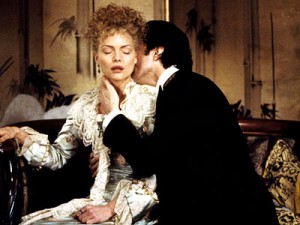 5. The Age of Innocence (1993) – Crafted like an origami opera. Aristocratic 1870’s New York is brought elegantly to life by Martin Scorsese, his classiest picture embellished with fur coats, horse carriages, yellow red and purple rose petals, opera houses and opulent ballrooms. Daniel Day-Lewis is the proper but evolving thinking Newland Archer, Michelle Pfieffer is the dreamy and audacious woman, Winona Ryder as the shallow but proper virgin that Day-Lewis is supposed to marry. The film occupies a time and place, and a feeling of blueblood snobbery unlike any other – the snipes made between people leave cruel marks. Edith Wharton’s people lived in a time of gorgeousness, wall to wall fanciness. But the people, oh so stifled in their uptight manners. In a way, lovers Day-Lewis and Pfieffer are renegades, attempting to get away with paltry transgressions that wouldn’t matter a hundred years later. There were no movies in 1870, but Scorsese’s film can serve as its time capsule.
5. The Age of Innocence (1993) – Crafted like an origami opera. Aristocratic 1870’s New York is brought elegantly to life by Martin Scorsese, his classiest picture embellished with fur coats, horse carriages, yellow red and purple rose petals, opera houses and opulent ballrooms. Daniel Day-Lewis is the proper but evolving thinking Newland Archer, Michelle Pfieffer is the dreamy and audacious woman, Winona Ryder as the shallow but proper virgin that Day-Lewis is supposed to marry. The film occupies a time and place, and a feeling of blueblood snobbery unlike any other – the snipes made between people leave cruel marks. Edith Wharton’s people lived in a time of gorgeousness, wall to wall fanciness. But the people, oh so stifled in their uptight manners. In a way, lovers Day-Lewis and Pfieffer are renegades, attempting to get away with paltry transgressions that wouldn’t matter a hundred years later. There were no movies in 1870, but Scorsese’s film can serve as its time capsule.
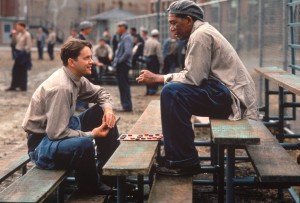 6. The Shawshank Redemption (1994) – In the early years I considered Tim Robbins, as the wrongly convicted murderer sentenced to life, to be the best performance. But as the years draw on and appreciation richens, Morgan Freeman delivers a performance of grace embodiment unsurpassed. Living with grace inside prison walls has really been the enduring theme of the Frank Darabont film (of a Stephen King novella). Long-lasting patience is another theme, and durable friendship is yet another. Iconic moments abound. Robbins, standing with open arms in the rain, as the camera ascends vertically, triumphantly, is one of cinema’s great images. I could rank this film higher but what is perhaps a greater shot was cut short by thirty seconds when before its original theatrical release, a test audience mistakenly thought it was over and began walking out too early: the camera swoops over blue Pacific waters of Mexico. I have waited nearly 20 years for Darabont to restore that shot in a new DVD edition but it has yet to come.
6. The Shawshank Redemption (1994) – In the early years I considered Tim Robbins, as the wrongly convicted murderer sentenced to life, to be the best performance. But as the years draw on and appreciation richens, Morgan Freeman delivers a performance of grace embodiment unsurpassed. Living with grace inside prison walls has really been the enduring theme of the Frank Darabont film (of a Stephen King novella). Long-lasting patience is another theme, and durable friendship is yet another. Iconic moments abound. Robbins, standing with open arms in the rain, as the camera ascends vertically, triumphantly, is one of cinema’s great images. I could rank this film higher but what is perhaps a greater shot was cut short by thirty seconds when before its original theatrical release, a test audience mistakenly thought it was over and began walking out too early: the camera swoops over blue Pacific waters of Mexico. I have waited nearly 20 years for Darabont to restore that shot in a new DVD edition but it has yet to come.
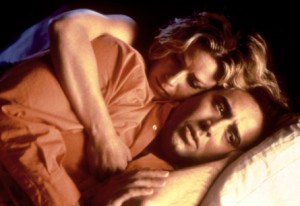 7. Leaving Las Vegas (1995) – One reason we choose to watch movies is to get a taste of a life that isn’t ours, whether it is a good life or lowly one. Nicolas Cage drives from Los Angeles to Vegas to blow it all and drink himself to death. A horrible trajectory, yet the film has a swaying, dizzying nothing-really-matters humor. Elizabeth Shue is the prostitute with a heart of gold but the grittiness, and skankiness, of the character remains true. Cage and Shue make an unlikely, defunct pair, but something glows. To love this film anyway is to learn that you have the capacity to love movies about losers. The first 22 minutes alone is a self-contained masterpiece with Cage in freefall, and the film would still be an art film masterpiece if it were just that. Director Mike Figgis chose Super 16mm, and with light cameras he had an impromptu freedom. In addition to writing and directing, Figgis wrote and composed the jazz score, and Sting contributed to the soundtrack, too.
7. Leaving Las Vegas (1995) – One reason we choose to watch movies is to get a taste of a life that isn’t ours, whether it is a good life or lowly one. Nicolas Cage drives from Los Angeles to Vegas to blow it all and drink himself to death. A horrible trajectory, yet the film has a swaying, dizzying nothing-really-matters humor. Elizabeth Shue is the prostitute with a heart of gold but the grittiness, and skankiness, of the character remains true. Cage and Shue make an unlikely, defunct pair, but something glows. To love this film anyway is to learn that you have the capacity to love movies about losers. The first 22 minutes alone is a self-contained masterpiece with Cage in freefall, and the film would still be an art film masterpiece if it were just that. Director Mike Figgis chose Super 16mm, and with light cameras he had an impromptu freedom. In addition to writing and directing, Figgis wrote and composed the jazz score, and Sting contributed to the soundtrack, too.
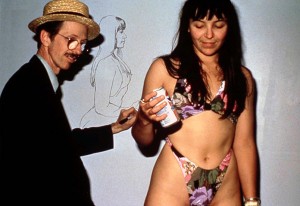 8. Crumb (1995) – I would never want to have lunch with Robert Crumb, I just don’t think we would get along. His geekiness is like smoldering cheese, and his brother Charles is as gross as charred flies on a wall. But I do think Terry Zwigoff made the best documentary feature ever made, about controversial supergeek who become a phenomenon in the comic book world. Even an unsuspected anti-fan like me eventually becomes awestruck by Robert’s work which is paneled within the film. Robert was reviled by some critics and editors who found that his promising early talent evolved into pornography (hence the controversy), although his satirical mind runs deep. “A Short History of America” is a comic strip of genius – it’s his cleanest work that stands out. As for Charles, well, he’s a casualty of what happens when you don’t put your dreams to pen and paper.
8. Crumb (1995) – I would never want to have lunch with Robert Crumb, I just don’t think we would get along. His geekiness is like smoldering cheese, and his brother Charles is as gross as charred flies on a wall. But I do think Terry Zwigoff made the best documentary feature ever made, about controversial supergeek who become a phenomenon in the comic book world. Even an unsuspected anti-fan like me eventually becomes awestruck by Robert’s work which is paneled within the film. Robert was reviled by some critics and editors who found that his promising early talent evolved into pornography (hence the controversy), although his satirical mind runs deep. “A Short History of America” is a comic strip of genius – it’s his cleanest work that stands out. As for Charles, well, he’s a casualty of what happens when you don’t put your dreams to pen and paper.
 9. Fargo (1996) – The Coen Brothers seriocomic snow-coated ransom plot has mirth and malice, but more than that, it is populated with characters like Marge Gunderson, a pregnant police chief investigating a multiple homicide. Frances McDormand, who won an Oscar, doesn’t even make an appearance in the film until the half-hour mark. The story’s slimeball is really a schmuck: Jerry Lundegaard (William H. Macy), who meets two second-rate skuzz-buckets (Steve Buscemi and Peter Stormare) to do his dirty work. The absurd plan is for Jerry to have his wife kidnapped by them so he can snatch most of the ransom paid by his wife’s father (Harv Presnell), a rich tightwad. Everything goes down in a series of deadpan misfires. The upper Midwest often gets shafted in the movies, but the Coen’s deliver the vernacular and every other touch with gumption.
9. Fargo (1996) – The Coen Brothers seriocomic snow-coated ransom plot has mirth and malice, but more than that, it is populated with characters like Marge Gunderson, a pregnant police chief investigating a multiple homicide. Frances McDormand, who won an Oscar, doesn’t even make an appearance in the film until the half-hour mark. The story’s slimeball is really a schmuck: Jerry Lundegaard (William H. Macy), who meets two second-rate skuzz-buckets (Steve Buscemi and Peter Stormare) to do his dirty work. The absurd plan is for Jerry to have his wife kidnapped by them so he can snatch most of the ransom paid by his wife’s father (Harv Presnell), a rich tightwad. Everything goes down in a series of deadpan misfires. The upper Midwest often gets shafted in the movies, but the Coen’s deliver the vernacular and every other touch with gumption.
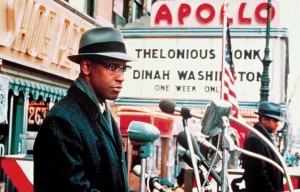 10. Malcolm X (1992) – Awesome and full of biography, full of geographical scope. Denzel Washington spans the historical figure from his hustler days in postwar Boston and Harlem, then through his prison conversion, his rise to preacher and then leader of the Black Muslim movement. The fireball orations have an unparalleled verbal command and intensity – it is a great film just to listen to his intelligence. The real coup of Spike Lee’s mastery is certain in the final hour of his three-hour and twenty minute epic: Malcolm’s philosophical conversion during his pilgrimage to Mecca where he changed his tune from segregation to embrace integration. And then, upon his return home, and following the inevitable assassination that would in return immortalize him, Lee documents the impact of his teachings across the contemporary globe with images of unity today. Washington’s performance is one of the greatest put on film – stirring, rousing and charismatic, modulating his rage to ultimately put fervor to good purpose.
10. Malcolm X (1992) – Awesome and full of biography, full of geographical scope. Denzel Washington spans the historical figure from his hustler days in postwar Boston and Harlem, then through his prison conversion, his rise to preacher and then leader of the Black Muslim movement. The fireball orations have an unparalleled verbal command and intensity – it is a great film just to listen to his intelligence. The real coup of Spike Lee’s mastery is certain in the final hour of his three-hour and twenty minute epic: Malcolm’s philosophical conversion during his pilgrimage to Mecca where he changed his tune from segregation to embrace integration. And then, upon his return home, and following the inevitable assassination that would in return immortalize him, Lee documents the impact of his teachings across the contemporary globe with images of unity today. Washington’s performance is one of the greatest put on film – stirring, rousing and charismatic, modulating his rage to ultimately put fervor to good purpose.
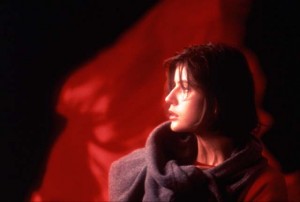 11. Red (1994, France) – The “Red, White, Blue” series by Krzystof Kieslowski is a tribute to the tri-colors of the French flag (the colors stand for fraternity, equality, liberty). All three are worth watching but this final chapter in the trilogy is the true masterpiece. “Red” explores fraternity in an unlikely way between a fashion runway model (Irene Jacob) and an old retired judge (Jean-Louis Trintignant) who spends long addictive hours spying on his neighbors via phone wiretap. She tells him how wrong he is in his actions, and, in an unspoken way, that she will resume their friendship if he stops spying. He is in love with her, but recognizes there is a 40-year age difference that separates them. He wonders had they been of the same age, grown up together in the same space and time, would she have been the perfect soul mate for him? Co-existing somewhere in the distance, in a parallel story, is a young man (Jean-Pierre Lorit) in law school with a bright future and an accomplished girlfriend. He is a passionate but moody young man whom we learn comprises the same characteristics of the judge – by similarities, will he grow into a brittle old man likewise or sidestep into a happier future? Everything leads to a fateful conclusion that ponders who in this world we are meant to meet, whom we are not, and what circumstances dictate the rest of our futures. Notably, throughout the series the color motifs are sharply utilized, but the cinematography has never been as perfect as it is here. This is a film of endless contemplation.
11. Red (1994, France) – The “Red, White, Blue” series by Krzystof Kieslowski is a tribute to the tri-colors of the French flag (the colors stand for fraternity, equality, liberty). All three are worth watching but this final chapter in the trilogy is the true masterpiece. “Red” explores fraternity in an unlikely way between a fashion runway model (Irene Jacob) and an old retired judge (Jean-Louis Trintignant) who spends long addictive hours spying on his neighbors via phone wiretap. She tells him how wrong he is in his actions, and, in an unspoken way, that she will resume their friendship if he stops spying. He is in love with her, but recognizes there is a 40-year age difference that separates them. He wonders had they been of the same age, grown up together in the same space and time, would she have been the perfect soul mate for him? Co-existing somewhere in the distance, in a parallel story, is a young man (Jean-Pierre Lorit) in law school with a bright future and an accomplished girlfriend. He is a passionate but moody young man whom we learn comprises the same characteristics of the judge – by similarities, will he grow into a brittle old man likewise or sidestep into a happier future? Everything leads to a fateful conclusion that ponders who in this world we are meant to meet, whom we are not, and what circumstances dictate the rest of our futures. Notably, throughout the series the color motifs are sharply utilized, but the cinematography has never been as perfect as it is here. This is a film of endless contemplation.
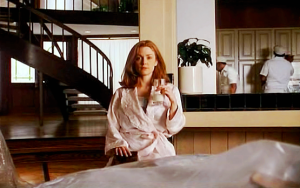 12. Safe (1995) – Disturbing, and a performance by Julianne Moore that I regard as one of the ten best ever put on film. Todd Haynes’ craftsmanship is up there with Welles and Kubrick with a complimenting trancelike Lynch quality. But be warned: this is oblique storytelling that is misleading about what it appears to be about. And for some people, it is too slow, while for others the anxiety and foreboding is enthralling. Moore plays an affluent but spiritually blank woman who suddenly has severe allergic reactions to her environment. Her solution is to abandon her posh Southern California lifestyle to join a New Age retreat in New Mexico, preserved away from city pollutants and toxins. What’s left is a cipher bereft of control. When Moore’s finds sanctuary she is actually giving up the things in life that are worth living for. Her big climactic monologue is dithering, and that lack of adult cognitive awareness is what makes her performance devastating.
12. Safe (1995) – Disturbing, and a performance by Julianne Moore that I regard as one of the ten best ever put on film. Todd Haynes’ craftsmanship is up there with Welles and Kubrick with a complimenting trancelike Lynch quality. But be warned: this is oblique storytelling that is misleading about what it appears to be about. And for some people, it is too slow, while for others the anxiety and foreboding is enthralling. Moore plays an affluent but spiritually blank woman who suddenly has severe allergic reactions to her environment. Her solution is to abandon her posh Southern California lifestyle to join a New Age retreat in New Mexico, preserved away from city pollutants and toxins. What’s left is a cipher bereft of control. When Moore’s finds sanctuary she is actually giving up the things in life that are worth living for. Her big climactic monologue is dithering, and that lack of adult cognitive awareness is what makes her performance devastating.
 13. The Silence of the Lambs (1991) – Terrifying and immersed into depraved psychosis. FBI agent-in-training Clarice Starling (Jodie Foster) consults the incarcerated serial killer Hannibal the Cannibal (Anthony Hopkins) to catch on-the-loose serial killer Buffalo Bill (Ted Levine, a great underrated performance). The sexual profiling of the killer as well as the clinical matter of fact dissection of the victims, builds up squirmy greatness. The camera shots of Clarice and Hannibal are head-on, and we gather that Hannibal will only cooperate in assisting the case if he can get inside Clarice’s attractive little head. Before this film, all serial killers were publicly perceived as whackjobs (probably drooling at the mouth, sputter nonsensical). Serial killers, like the ones here, are still whackjobs but they are also startlingly articulate, deceptive, scheming, and demoralized with a specific trophy-minded purpose.
13. The Silence of the Lambs (1991) – Terrifying and immersed into depraved psychosis. FBI agent-in-training Clarice Starling (Jodie Foster) consults the incarcerated serial killer Hannibal the Cannibal (Anthony Hopkins) to catch on-the-loose serial killer Buffalo Bill (Ted Levine, a great underrated performance). The sexual profiling of the killer as well as the clinical matter of fact dissection of the victims, builds up squirmy greatness. The camera shots of Clarice and Hannibal are head-on, and we gather that Hannibal will only cooperate in assisting the case if he can get inside Clarice’s attractive little head. Before this film, all serial killers were publicly perceived as whackjobs (probably drooling at the mouth, sputter nonsensical). Serial killers, like the ones here, are still whackjobs but they are also startlingly articulate, deceptive, scheming, and demoralized with a specific trophy-minded purpose.
 14. Heat (1995) – The Los Angeles set crime saga that pairs Robert DeNiro and Al Pacino as opponents (yet united by their consummate honor for what they choose to do), is the greatest of all cops and robbers movies. The range of cast – and how they fit into the vast story canvas – is extraordinary, and there must be twelve unforgettable characters (Val Kilmer, Natalie Portman, Tom Sizemore, Ashley Judd, Jon Voight among them). The cataclysmic street battle at the two hour mark, which begins as organized tag team shooting and then turns into a bloodbath royale, is among the two or three best shootouts ever. Inundated criticism suggested that Pacino’s shouting was over-the-top, but it’s really one of his best performances. When he’s shouting, he’s really acting out his daily addiction to rage and in being the showboat cop in his division. DeNiro is an emotionless humanoid but only because his motto is “pros have to be able to walk away from everything in 30 seconds flat if you feel the heat around the corner.” The end result is a street smart blast.
14. Heat (1995) – The Los Angeles set crime saga that pairs Robert DeNiro and Al Pacino as opponents (yet united by their consummate honor for what they choose to do), is the greatest of all cops and robbers movies. The range of cast – and how they fit into the vast story canvas – is extraordinary, and there must be twelve unforgettable characters (Val Kilmer, Natalie Portman, Tom Sizemore, Ashley Judd, Jon Voight among them). The cataclysmic street battle at the two hour mark, which begins as organized tag team shooting and then turns into a bloodbath royale, is among the two or three best shootouts ever. Inundated criticism suggested that Pacino’s shouting was over-the-top, but it’s really one of his best performances. When he’s shouting, he’s really acting out his daily addiction to rage and in being the showboat cop in his division. DeNiro is an emotionless humanoid but only because his motto is “pros have to be able to walk away from everything in 30 seconds flat if you feel the heat around the corner.” The end result is a street smart blast.
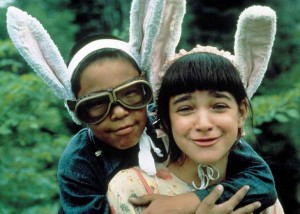 15. Map of the Human Heart (1993) – Spans four decades and spreads three continents, Avik is an Eskimo in the 1930’s who follows his childhood love Albertine around the world (Jason Scott Lee and Anne Parillaud play them as adults). First love begins at a Canadian orphanage, but she is separated from him, and grows up among the noble class. As a man, he joins the Royal Canadian Air Force, participating in the firebombing of Dresden (he vows to miss his targets to avoid causing human casualties), so he can travel to her part of the world. “Human Heart” features my favorite sex scene, not because it is explicitly erotic but because it is visually evocative and unabashedly romantic, occurring after the lovers have waited well over ten years for the right time to embrace. Director Vincent Ward (“What Dreams May Come”) seems to be working from the subconscious realm – his imagery is impressionistic, conjuring dreaminess and yearning. No clunky gone-with-the-wind stuff, these are characters who make every minute of their life matter. I could have picked “The Piano,” but over the years, I love “Human Heart” way more. It’s time someone at least considers this a candidate for most romantic film ever made.
15. Map of the Human Heart (1993) – Spans four decades and spreads three continents, Avik is an Eskimo in the 1930’s who follows his childhood love Albertine around the world (Jason Scott Lee and Anne Parillaud play them as adults). First love begins at a Canadian orphanage, but she is separated from him, and grows up among the noble class. As a man, he joins the Royal Canadian Air Force, participating in the firebombing of Dresden (he vows to miss his targets to avoid causing human casualties), so he can travel to her part of the world. “Human Heart” features my favorite sex scene, not because it is explicitly erotic but because it is visually evocative and unabashedly romantic, occurring after the lovers have waited well over ten years for the right time to embrace. Director Vincent Ward (“What Dreams May Come”) seems to be working from the subconscious realm – his imagery is impressionistic, conjuring dreaminess and yearning. No clunky gone-with-the-wind stuff, these are characters who make every minute of their life matter. I could have picked “The Piano,” but over the years, I love “Human Heart” way more. It’s time someone at least considers this a candidate for most romantic film ever made.
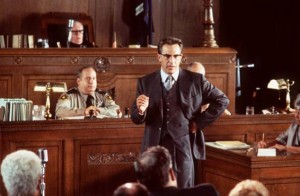 16. JFK (1991) – Blending in different kinds of film stock, arrays of lighting arrangements, and fusions of color and black & white, Oliver Stone employs hallucinatory visual styles, but really he’s expanding our minds in the process. The documentary form was influenced, too: Can you imagine “No End in Sight,” “Bowling for Columbine,” “Why We Fight,” “Taxi to the Dark Side,” and “The Corporation” existing without Stone’s influential hand? Some have never seen it because they are offended by hearsay, that facts were manipulated. The truth is this film is always upfront, about what is and what is not speculative, through the eyes of District Attorney Jim Garrison (Kevin Costner). Garrison put CIA agent Clay Shaw (Tommy Lee Jones) on trial because there was enough evidence that he was complicit to the assassination of our 35th president. Often the central message has been misinterpreted, that Stone’s work is a brainwashing conspiracy theory. The message is that government information to the citizen is parceled out through slanted media information, and in some way we’re always going to be left a little in the dark because we’re not asking the right questions.
16. JFK (1991) – Blending in different kinds of film stock, arrays of lighting arrangements, and fusions of color and black & white, Oliver Stone employs hallucinatory visual styles, but really he’s expanding our minds in the process. The documentary form was influenced, too: Can you imagine “No End in Sight,” “Bowling for Columbine,” “Why We Fight,” “Taxi to the Dark Side,” and “The Corporation” existing without Stone’s influential hand? Some have never seen it because they are offended by hearsay, that facts were manipulated. The truth is this film is always upfront, about what is and what is not speculative, through the eyes of District Attorney Jim Garrison (Kevin Costner). Garrison put CIA agent Clay Shaw (Tommy Lee Jones) on trial because there was enough evidence that he was complicit to the assassination of our 35th president. Often the central message has been misinterpreted, that Stone’s work is a brainwashing conspiracy theory. The message is that government information to the citizen is parceled out through slanted media information, and in some way we’re always going to be left a little in the dark because we’re not asking the right questions.
 17. The Fugitive (1993) – Harrison Ford on the run for his life after being wrongly accused for murdering his wife. The built-in agony: What husband would want to murder beautiful Sela Ward? Ford, the former vascular surgeon, returns home to Chicago to find the clues that will clear his name. On his trail is the gruff Tommy Lee Jones as a Deputy U.S. Marshall, and before you know it, you are actually rooting for both the innocent man and the pursuer. The cunning chase sequences are craftier than most action pictures due to those unbroken, gliding tracking shots engineered by director Andrew Davis (he also made Steven Seagal’s best film “Under Siege”). Ford, with his physical deftness, makes us feel what he’s feeling while the world closes in on him. Jones whips up a character who you admire strongly for his tenacious professional pledge.
17. The Fugitive (1993) – Harrison Ford on the run for his life after being wrongly accused for murdering his wife. The built-in agony: What husband would want to murder beautiful Sela Ward? Ford, the former vascular surgeon, returns home to Chicago to find the clues that will clear his name. On his trail is the gruff Tommy Lee Jones as a Deputy U.S. Marshall, and before you know it, you are actually rooting for both the innocent man and the pursuer. The cunning chase sequences are craftier than most action pictures due to those unbroken, gliding tracking shots engineered by director Andrew Davis (he also made Steven Seagal’s best film “Under Siege”). Ford, with his physical deftness, makes us feel what he’s feeling while the world closes in on him. Jones whips up a character who you admire strongly for his tenacious professional pledge.
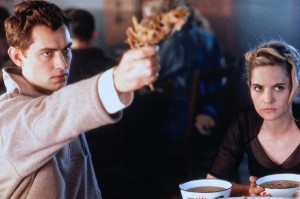 18. eXistenZ (1999) – Released just weeks after “The Matrix.” David Cronenberg has been justly acclaimed for years now, but how is it that his greatest film – one of the great mindbenders of our time – been seen by far less viewership? Working as a sci-fi cautionary tale worthy of the best Philip K. Dick literature, Jude Law and Jennifer Jason Leigh are partners lost in a virtual reality game that engages in violence, intrigue and identity crisis. But Cronenberg’s interest is really about the grotesque human desire to desecrate our flesh in order to obtain mind-blowing highs, with players whom willingly use a techno bioport to plug into their spines. You will be grossed out some.
18. eXistenZ (1999) – Released just weeks after “The Matrix.” David Cronenberg has been justly acclaimed for years now, but how is it that his greatest film – one of the great mindbenders of our time – been seen by far less viewership? Working as a sci-fi cautionary tale worthy of the best Philip K. Dick literature, Jude Law and Jennifer Jason Leigh are partners lost in a virtual reality game that engages in violence, intrigue and identity crisis. But Cronenberg’s interest is really about the grotesque human desire to desecrate our flesh in order to obtain mind-blowing highs, with players whom willingly use a techno bioport to plug into their spines. You will be grossed out some.
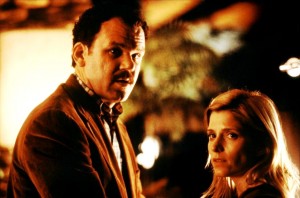 19. Magnolia (1999) – Emotionally draining but ultimately exhilarating Paul Thomas Anderson symphony film. I knew it was a great when I sleepless one night at 4 a.m., I had turned on cable and found it for an intended minute (I had already seen it three times), and relinquished myself to watch it again, from beginning to end, as if it held answers to my life. We as people are all connected by something, and maybe we would learn something if we all communicated better with each other. Anderson’s interlinks nine Los Angeles people en route to personal destruction before the skies rain down a divine intervention that brings down the walls of shame. Among them are Tom Cruise as a seduce and destroyer, Philip Baker Hall as a game show host diagnosed with cancer, Melora Walters as his hermit-druggie daughter, Jason Robards as a dying rich S.O.B., and Julianne Moore as his trophy wife. Somehow, all of this comes out exultant in terms of filmmaking and message. As a viewer, you have to posit the idea that sometimes you have to get through all the piss and shit, transcend above it, before you get to the good stuff.
19. Magnolia (1999) – Emotionally draining but ultimately exhilarating Paul Thomas Anderson symphony film. I knew it was a great when I sleepless one night at 4 a.m., I had turned on cable and found it for an intended minute (I had already seen it three times), and relinquished myself to watch it again, from beginning to end, as if it held answers to my life. We as people are all connected by something, and maybe we would learn something if we all communicated better with each other. Anderson’s interlinks nine Los Angeles people en route to personal destruction before the skies rain down a divine intervention that brings down the walls of shame. Among them are Tom Cruise as a seduce and destroyer, Philip Baker Hall as a game show host diagnosed with cancer, Melora Walters as his hermit-druggie daughter, Jason Robards as a dying rich S.O.B., and Julianne Moore as his trophy wife. Somehow, all of this comes out exultant in terms of filmmaking and message. As a viewer, you have to posit the idea that sometimes you have to get through all the piss and shit, transcend above it, before you get to the good stuff.
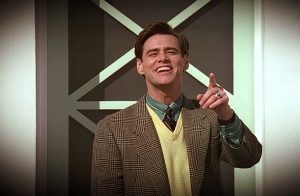 20. The Truman Show (1998) – On the air unaware. Jim Carrey, as Truman Burbank, is at once goofy, awkward and displaced plucked inside the world’s largest observation bubble and broadcast to the world. Cameras are everywhere to capture everything, some of them small as peanuts. His supplanted wife (Laura Linney) is insincere and two-faced, the real woman of his dreams (Natascha McElhone) is off in a paradise called Fiji. Or just outside the Burbank studio dome. The most plausible part of the concept is that the artificial Seahaven where Truman resides is actually cleaner and cozier than the world we live in, and so it is not impossible to envy him. But the human experience is a quest for truth, and we cheer Truman on to get enough courageous mojo to break the borders.
20. The Truman Show (1998) – On the air unaware. Jim Carrey, as Truman Burbank, is at once goofy, awkward and displaced plucked inside the world’s largest observation bubble and broadcast to the world. Cameras are everywhere to capture everything, some of them small as peanuts. His supplanted wife (Laura Linney) is insincere and two-faced, the real woman of his dreams (Natascha McElhone) is off in a paradise called Fiji. Or just outside the Burbank studio dome. The most plausible part of the concept is that the artificial Seahaven where Truman resides is actually cleaner and cozier than the world we live in, and so it is not impossible to envy him. But the human experience is a quest for truth, and we cheer Truman on to get enough courageous mojo to break the borders.
Fun Movies 1990’s: “Joe versus the Volcano” (1990); “Die Hard 2: Die Harder” (1990); “Cape Fear” (1991); “Dead Again” (1991); “Defending Your Life” (1991); “L.A. Story” (1991); “The Naked Gun 2 1/2: The Smell of Fear” (1991); “Under Siege” (1992); “My Cousin Vinny” (1992); “Groundhog Day” (1993); “Carlito’s Way” (1993); “The Hudsucker Proxy” (1994); “It Could Happen To You” (1994); “Dumb & Dumber” (1994); “Toy Story” (1995); “Kingpin” (1996); “Flirting with Disaster” (1996); “Mission: Impossible” (1996); “The Game” (1997); “Boogie Nights” (1997); “Romy & Michelle’s High School Reunion” (1997); “Austin Powers: International Man of Mystery” (1997); “The Big Lebowski” (1998); “Babe: Pig in the City” (1998); “There’s Something About Mary” (1998); “The Sixth Sense” (1999); “The Matrix” (1999); “Run Lola Run” (1999, Germany); “Office Space” (1999); “Mumford” (1999).
In six months, I’ll cover the 1980’s.




